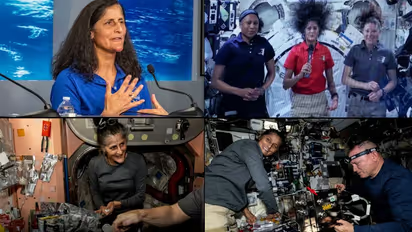'I’m the same weight that I was': Sunita Williams rubbishes health fears, insists 'my butt is bigger' (WATCH)

Synopsis
Indian-origin NASA astronaut Sunita Williams, who continues her extended mission aboard the International Space Station (ISS), recently addressed rather dismissed swirling concerns about her health that were fueled by images of her appearing notably leaner.
Indian-origin NASA astronaut Sunita Williams, who continues her extended mission aboard the International Space Station (ISS), recently addressed swirling concerns about her health that were fueled by images of her appearing notably leaner. The photos led to speculation about possible health challenges during her prolonged stay in microgravity.
Williams, however, was quick to clarify. She attributed her slimmed-down appearance to "fluid shifts" commonly experienced in space, where the absence of gravity causes bodily fluids to move upward, often creating a slimmer look in the face.
"I’m the same weight that I was when I got up here," Williams emphasized, reassuring the public that her health remains robust.
NASA also chimed in to dispel the rumors, confirming that astronauts aboard the ISS are subject to thorough, regular health assessments to ensure they stay in peak condition during extended missions.
Williams explained how, despite the appearance changes, her health has only improved, with her exercise regime focusing on muscle retention and bone density, thanks to space-ready gear like treadmills, stationary bikes, and resistance machines.
“Weightlifting... has definitely changed me. My thighs are a little bit bigger, my butt is a little bit bigger,” she said with a smile.
In fact, NASA has been actively researching these "fluid shifts" and their impact on astronauts, especially the effects of intracranial pressure and potential impacts on vision.
According to NASA’s studies, microgravity’s influence can sometimes cause retinal swelling, affecting visual capacity – a condition NASA closely monitors among its crew.
Williams’ mission, alongside fellow astronaut Butch Wilmore, has been extended far beyond the originally planned 10 days due to technical issues with the Starliner capsule’s thrusters. After multiple malfunctions, NASA decided to return the Starliner unmanned. Now, Williams and Wilmore are scheduled to return to Earth in February 2025 aboard SpaceX’s Crew Dragon capsule, along with Crew-9 astronauts Nick Hague of NASA and Russian cosmonaut Aleksandr Gorbunov.
Check the Breaking News Today and Latest News from across India and around the world. Stay updated with the latest World News and global developments from politics to economy and current affairs. Get in-depth coverage of China News, Europe News, Pakistan News, and South Asia News, along with top headlines from the UK and US. Follow expert analysis, international trends, and breaking updates from around the globe. Download the Asianet News Official App from the Android Play Store and iPhone App Store for accurate and timely news updates anytime, anywhere.